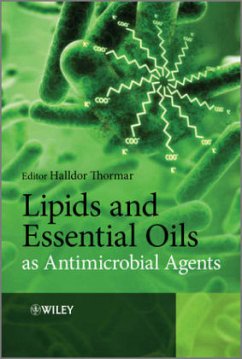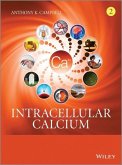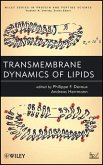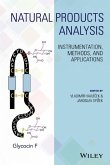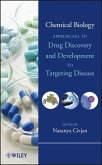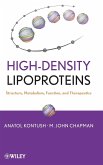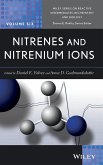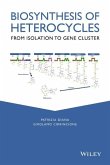Lipids and Essential Oils as Antimicrobial Agents
Herausgegeben von Thormar, Halldor
Lipids and Essential Oils as Antimicrobial Agents
Herausgegeben von Thormar, Halldor
- Gebundenes Buch
- Merkliste
- Auf die Merkliste
- Bewerten Bewerten
- Teilen
- Produkt teilen
- Produkterinnerung
- Produkterinnerung
Lipids and essential oils have strong antimicrobial properties -- they kill or inhibit the growth of microbes such as bacteria, fungi, or viruses. They are being studied for use in the prevention and treatment of infections, as potential disinfectants, and for their preservative and antimicrobial properties when formulated as pharmaceuticals, in food products, and in cosmetics.
Lipids and Essential Oils as Antimicrobial Agents is a comprehensive review of the scientific knowledge in this field. International experts provide summaries on:
the chemical and biological properties of lipids…mehr
Andere Kunden interessierten sich auch für
![Intracellular Calcium, 2 Volume Set Intracellular Calcium, 2 Volume Set]() Anthony K. CampbellIntracellular Calcium, 2 Volume Set344,99 €
Anthony K. CampbellIntracellular Calcium, 2 Volume Set344,99 €![Transmembrane Dynamics of Lipids Transmembrane Dynamics of Lipids]() Andreas HerrmannTransmembrane Dynamics of Lipids189,99 €
Andreas HerrmannTransmembrane Dynamics of Lipids189,99 €![Natural Products Analysis Natural Products Analysis]() Natural Products Analysis185,99 €
Natural Products Analysis185,99 €![Chemical Biology Chemical Biology]() Natanya CivjanChemical Biology164,99 €
Natanya CivjanChemical Biology164,99 €![High-Density Lipoproteins High-Density Lipoproteins]() Anatol KontushHigh-Density Lipoproteins186,99 €
Anatol KontushHigh-Density Lipoproteins186,99 €![Nitrenes and Nitrenium Ions Nitrenes and Nitrenium Ions]() Nitrenes and Nitrenium Ions167,99 €
Nitrenes and Nitrenium Ions167,99 €![Biosynthesis of Heterocycles Biosynthesis of Heterocycles]() Patrizia DianaBiosynthesis of Heterocycles239,99 €
Patrizia DianaBiosynthesis of Heterocycles239,99 €-
-
-
Lipids and essential oils have strong antimicrobial properties -- they kill or inhibit the growth of microbes such as bacteria, fungi, or viruses. They are being studied for use in the prevention and treatment of infections, as potential disinfectants, and for their preservative and antimicrobial properties when formulated as pharmaceuticals, in food products, and in cosmetics.
Lipids and Essential Oils as Antimicrobial Agents is a comprehensive review of the scientific knowledge in this field. International experts provide summaries on:
the chemical and biological properties of lipids and essential oils
use of lipids and essential oils in pharmaceuticals, cosmetics and health foods
antimicrobial effects of lipids
in vivo and in vitro
antimicrobial lipids in milk
antimicrobial lipids of the skin
antibacterial lipids as sanitizers and disinfectants
antibacterial, antifungal, and antiviral activities of essential oils
antimicrobial lipids in milk
antimicrobial lipids of the skin
antibacterial lipids as sanitizers and disinfectants
antibacterial, antifungal, and antiviral activities of essential oils
Lipids and Essential Oils as Antimicrobial Agents is an essential guide to this important topic for researchers and advanced students in academia and research working in pharmaceutical, cosmetic and food sciences, biochemistry and natural products chemistry, microbiology; and for health care scientists and professionals working in the fields of public health and infectious diseases. It will also be of interest to anyone concerned about health issues and particularly to those who are conscious of the benefits of health food and natural products.
Hinweis: Dieser Artikel kann nur an eine deutsche Lieferadresse ausgeliefert werden.
Lipids and Essential Oils as Antimicrobial Agents is a comprehensive review of the scientific knowledge in this field. International experts provide summaries on:
the chemical and biological properties of lipids and essential oils
use of lipids and essential oils in pharmaceuticals, cosmetics and health foods
antimicrobial effects of lipids
in vivo and in vitro
antimicrobial lipids in milk
antimicrobial lipids of the skin
antibacterial lipids as sanitizers and disinfectants
antibacterial, antifungal, and antiviral activities of essential oils
antimicrobial lipids in milk
antimicrobial lipids of the skin
antibacterial lipids as sanitizers and disinfectants
antibacterial, antifungal, and antiviral activities of essential oils
Lipids and Essential Oils as Antimicrobial Agents is an essential guide to this important topic for researchers and advanced students in academia and research working in pharmaceutical, cosmetic and food sciences, biochemistry and natural products chemistry, microbiology; and for health care scientists and professionals working in the fields of public health and infectious diseases. It will also be of interest to anyone concerned about health issues and particularly to those who are conscious of the benefits of health food and natural products.
Hinweis: Dieser Artikel kann nur an eine deutsche Lieferadresse ausgeliefert werden.
Produktdetails
- Produktdetails
- Verlag: Wiley & Sons
- 1. Auflage
- Seitenzahl: 336
- Erscheinungstermin: 14. Februar 2011
- Englisch
- Abmessung: 249mm x 173mm x 23mm
- Gewicht: 726g
- ISBN-13: 9780470741788
- ISBN-10: 0470741783
- Artikelnr.: 32568176
- Herstellerkennzeichnung
- Libri GmbH
- Europaallee 1
- 36244 Bad Hersfeld
- 06621 890
- Verlag: Wiley & Sons
- 1. Auflage
- Seitenzahl: 336
- Erscheinungstermin: 14. Februar 2011
- Englisch
- Abmessung: 249mm x 173mm x 23mm
- Gewicht: 726g
- ISBN-13: 9780470741788
- ISBN-10: 0470741783
- Artikelnr.: 32568176
- Herstellerkennzeichnung
- Libri GmbH
- Europaallee 1
- 36244 Bad Hersfeld
- 06621 890
Professor Halldor Thormar, Emeritus Professor, Institute of Biology, University of Iceland Professor Thormar has studied the antimicrobial effects of lipids for over 25 years, with more than 100 publications in the field.
List of Contributors xi
Introduction xiii
1 Membranes as Targets of Antimicrobial Lipids 1
Peter J. Quinn
1.1 Introduction 2
1.2 Oil and Water Don't Mix! 2
1.3 Polar Lipids 3
1.3.1 The Amphiphilic Character of Polar Lipids 3
1.3.2 Hydrophobic Constituents of Lipids 4
1.3.3 Polar Groups of Complex Lipids 5
1.4 Properties of Surfactants 7
1.4.1 Critical Micelle Concentration 7
1.4.2 Aggregation of Surface-Active Molecules 8
1.4.3 The Influence of Solvent 9
1.5 Cell Membranes 11
1.5.1 Membrane Lipids 11
1.5.2 Lipid Domains in Membranes 13
1.5.3 Membrane Proteins 15
1.5.4 Membrane Stability 15
1.5.4.1 Membrane Lipid Phase Behaviour 17
1.5.4.2 Membrane Lipid Homeostasis in Homoiothermic Organisms 18
1.5.4.3 Membrane Lipid Adaption in Poikilothermic Organisms 19
1.6 The Action of Antimicrobial Lipids on Cell Membranes 20
1.7 Conclusions 21
Acknowledgements 21
References 22
2 Antibacterial Effects of Lipids: Historical Review (1881 to 1960) 25
Halldor Thormar
2.1 Introduction 25
2.2 Antibacterial Activity of Soaps 26
2.2.1 Antibacterial Action of Fatty Acids and Their Derivatives 29
2.3 Inhibition of Lipids and Serum Albumin against the Antibacterial Action
of Soaps 33
2.4 Diverse Actions of Fatty Acids and Their Salts on Bacteria 34
2.5 The Nature of the Bactericidal Action of Fatty Acids 36
2.6 A Possible Role of Soaps and Fatty Acids in Host Defence against
Bacteria 38
2.7 Studies of Prophylactic and Therapeutic Applications of Soaps and Fatty
Acids 40
2.8 Conclusions 43
References 43
3 Antibacterial, Antiviral and Antifungal Activities of Lipids 47
Gudmundur Bergsson, Hilmar Hilmarsson and Halldor Thormar
3.1 Introduction 48
3.2 Antibacterial Activities of Fatty Acids and Monoglycerides 48
3.2.1 Activities against Gram-Positive Bacteria In Vitro 48
3.2.2 Activities against Gram-Negative Bacteria In Vitro 51
3.2.3 Antibacterial Mechanism 53
3.2.4 A Possible Role of Antimicrobial Lipids in Host Defence against
Bacteria 57
3.3 Antiviral Activities of Fatty Alcohols, Fatty Acids and Monoglycerides
58
3.3.1 Early Studies of Antiviral Lipids 58
3.3.2 Antiviral Activities of Milk Lipids 60
3.3.3 Antiviral Activities of Lipids and Fatty Alcohols 61
3.3.4 Antiviral Mechanism of Lipids 65
3.4 Antifungal Activities of Fatty Acids and Monoglycerides 67
3.4.1 In Vitro Studies 67
3.4.2 In Vivo Studies 71
3.5 Conclusions 74
References 75
4 Antimicrobial Lipids in Milk 81
Charles E. Isaacs
4.1 Introduction 82
4.2 Occurrence 83
4.2.1 Biosynthesis 83
4.2.2 Quantitative Assays 83
4.2.2.1 Measurement of Antibacterial Activity 83
4.2.2.2 Measurement of Antiviral Activity 84
4.3 Molecular Properties 84
4.3.1 Lipids in Milk and Plant Oils 84
4.3.2 Dependence of Antimicrobial Activity on Chain Length, Saturation and
pH 85
4.4 Antimicrobial Activity 85
4.4.1 Mechanism of Action 85
4.4.2 Synergy between Antimicrobial Lipids and Antimicrobial Peptides 87
4.4.2.1 Antimicrobial Peptides and Proteins 87
4.4.2.2 Potential Synergism between Antimicrobial Milk Lipids and Peptides
88
4.4.3 Influencing Factors 88
4.4.4 Spectrum 89
4.5 Applications 89
4.5.1 Additive Advantage to Foods and Biological Products 89
4.5.2 Physiological Advantage 90
4.5.3 Sexually Transmitted Pathogens and Topical Activity 91
4.6 Safety, Tolerance and Efficacy 91
4.7 Conclusions 92
References 92
5 Antimicrobial Lipids of the Skin and Tear Film 99
Carol L. Bratt, Phil Wertz, David Drake, Deborah V. Dawson and Kim A.
Brogden
5.1 Introduction 100
5.2 Innate Immune Mechanisms in Skin 101
5.2.1 The Extensive Cutaneous Microbial Burden 101
5.2.2 Cutaneous Innate Immune Mechanisms 104
5.3 Types and Locations of Lipids of the Skin and Tear Film 106
5.3.1 Hypodermal and Dermal Lipids 107
5.3.2 Epidermal Lipids 107
5.3.3 Secreted Lipids 109
5.3.4 Tear-Film Lipids 109
5.4 Functions of Lipids 111
5.4.1 Cutaneous Lipids as Permeability Barriers 111
5.4.2 Cutaneous Lipids as Innate Immune Mechanisms 111
5.5 Antimicrobial Activity of Lipids and Their Mechanisms of Killing 111
5.5.1 Lipid Deficiencies 112
5.5.2 Lipid Antimicrobial Activity and Mechanism of Action 112
5.5.2.1 Sphingolipids 113
5.5.2.2 Fatty acids 114
5.6 Synergy of Cutaneous Lipids and Other Innate Immune Molecules 114
5.7 Lipids as Therapeutic Agents 115
5.8 Conclusions 115
Acknowledgements 116
References 116
6 Antimicrobial Lipids and Innate Immunity 123
Halldor Thormar
6.1 Introduction 124
6.2 The Role of Human Milk Lipids in Innate Immunity 126
6.2.1 Breast-Feeding Protects Infants against Infection 126
6.2.2 Factors in Human Milk which Protect against Infection 127
6.2.3 Antmicrobial Lipids in Human Milk and Their Possible Protective
Function 129
6.3 Antimicrobial Lipids in the Pulmonary Mucosa 134
6.3.1 The Innate Immune System of the Respiratory Tract 134
6.3.2 Antimicrobial Fatty Acids in the Alveoli of Animal and Human Lungs
135
6.4 Antimicrobial Skin Lipids 137
6.4.1 The Self-Disinfecting Power of the Human Skin 137
6.4.2 The Role of Skin Lipids in the Self-Disinfection of Human Skin 137
6.4.3 Sebum Lipids as a Source of Antimicrobial Fatty Acids in the Skin 139
6.4.4 Stratum Corneum as a Source of Antimicrobial Lipids in the Skin 142
6.4.5 Antimicrobial Lipids as a Part of the Innate Immune Defence 144
6.5 Conclusions 144
References 144
7 Lipids as Active Ingredients in Pharmaceuticals, Cosmetics and Health
Foods 151
Thórdís Kristmundsdóttir and Skúli Skúlason
7.1 Introduction 152
7.2 Antimicrobial Effects of Lipids 152
7.2.1 Antibacterial Activity 152
7.2.2 Antiviral Activity 153
7.2.3 Antifungal Activity 154
7.3 Lipids in Pharmaceuticals 155
7.3.1 Lipids in Pharmacopeias 155
7.3.2 Microbicidal Lipids for Treatment of Mucosal and Skin Infections 155
7.3.3 Lipids as Penetration Enhancers in Pharmaceutical Dosage Forms 159
7.4 Microbicidal Lipids in Agriculture and Aquaculture 160
7.5 Lipids in Therapy 163
7.5.1 Effect of Lipids on Infectious and Inflammatory Diseases 163
7.5.2 Effect of Lipids on Psoriasis 165
7.5.3 Effect of Lipids on Cardiovascular Diseases 165
7.5.4 Effect of Lipids on Cognitive Function 166
7.6 Lipids in Cosmetics 167
7.6.1 Sources of Lipids Used in Cosmetics 167
7.6.2 Antimicrobial Activity of Lipids in Cosmetics 168
7.6.3 Other Activities of Lipids in Cosmetics 169
7.7 Lipids in Health Food 169
7.8 Conclusions 171
References 171
8 Antimicrobial Lipids as Disinfectants, Antiseptics and Sanitizers 179
Halldor Thormar and Hilmar Hilmarsson
8.1 Introduction 179
8.2 Soaps as Disinfectants and Antiseptics 182
8.3 Use of Bactericidal Lipids to Reduce Microbial Contamination of Food
Products 184
8.4 Killing of Foodborne Bacteria by Glycerol Monocaprate (Monocaprin)
Emulsions 186
8.4.1 Reduction of Viable Campylobacter in Drinking Water and Feed of
Chickens by Addition of Monocaprin Emulsions 187
8.4.2 Reduction of Viable Campylobacter on Poultry Carcasses 188
8.4.3 Reduction of Psychrotrophic Spoilage Bacteria on Chicken Carcasses
191
8.4.4 Sanitation of Kitchen Surfaces by Washing with Monocaprin Emulsions
194
8.5 Conclusions 197
References 197
9 Chemistry and Bioactivity of Essential Oils 203
Christine F. Carson and Katherine A. Hammer
9.1 Introduction 204
9.2 Chemistry of Essential Oils 205
9.2.1 Terpenes 205
9.2.1.1 Biosynthesis of Terpenes 206
9.2.1.2 Monoterpenes 206
9.2.1.3 Sesquiterpenes 208
9.2.1.4 Diterpenes 208
9.2.1.5 Norterpenes 209
9.2.2 Phenylpropanoids 209
9.2.2.1 Biosynthesis of Phenylpropanoids 209
9.2.2.2 Phenylpropanoids in Essential Oils 210
9.2.3 Sulfur and Nitrogen Compounds of Essential Oils 210
9.3 Biological Activity of Essential Oils 211
9.3.1 General Overview 211
9.3.2 Antimicrobial Activity 212
9.3.2.1 Antibacterial Activity 212
9.3.2.2 Antifungal Activity 215
9.3.2.3 Mechanisms of Antibacterial and Antifungal Action 216
9.3.2.4 Antiviral Activity 216
9.3.2.5 Antiprotozoal Activity 218
9.3.3 Anticancer Activity 219
9.4 Uses of Essential Oils 221
9.4.1 Pharmaceutical Products 221
9.4.2 Foods and Beverages 222
9.5 Conclusions 223
References 223
10 Antiviral Effects of Plant-Derived Essential Oils and Pure Oil
Components 239
Paul Schnitzler, Akram Astani and Jürgen Reichling
10.1 Introduction 239
10.2 Characterization and Medicinal Use of Essential Oils 240
10.3 Cytotoxicity of Essential Oils 240
10.4 Antiviral Activities of Essential oils 241
10.4.1 In Vitro and In Vivo Studies of Antiherpesvirus Activity of
Essential Oils 241
10.4.2 In Vitro and In Vivo Studies of Antiherpesvirus Activity of Pure
Essential Oil Components 247
10.4.3 In Vitro and In Vivo Studies of Antiviral Effects of Essential Oils
against Other Viruses 248
10.5 Mode of Antiviral Action of Essential Oils 250
10.6 Conclusions 251
References 252
11 Antibacterial and Antifungal Activities of Essential Oils 255
Katherine A. Hammer and Christine F. Carson
11.1 Introduction 256
11.2 Methods for Quantifying Antimicrobial Activity 257
11.3 Antibacterial and Antifungal Essential Oils by Plant Family 258
11.3.1 Apiaceae 258
11.3.2 Lamiaceae 258
11.3.3 Lauraceae 263
11.3.4 Myrtaceae 264
11.3.5 Poaceae 265
11.3.6 Rutaceae 266
11.3.7 Other 266
11.3.8 Comparative Activities of Essential Oils 266
11.4 Antimicrobial Essential-Oil Components 267
11.4.1 Aldehydes 267
11.4.2 Alcohols 267
11.4.3 Phenols 268
11.4.4 Ketones 269
11.4.5 Esters 269
11.4.6 Oxides and Epoxides 270
11.4.7 Methyl Ethers 270
11.4.8 Terpene Hydrocarbons 270
11.4.9 Generalizations about Component Activity 271
11.5 Factors Influencing Activity 271
11.5.1 Microorganism-Related Factors 271
11.5.2 Environmental Conditions 272
11.6 Mechanisms of Action 274
11.6.1 Membrane and Membrane-Related Actions 274
11.6.2 Adaptation and Tolerance 276
11.6.2.1 Resistance 278
11.6.3 Other Antimicrobial Effects 279
11.6.3.1 Toxins, Enzymes and Virulence Factors 279
11.6.3.2 Biofilms and Quorum Sensing 280
11.6.3.3 Synergy between Essential Oils or with Other Compounds 281
11.6.3.4 Other 282
11.7 Clinical Efficacy of Essential Oils and Components 282
11.7.1 Animal Studies 282
11.7.2 Human Studies 288
11.8 Toxicity of Essential Oils 288
11.8.1 In Vitro Toxicity Assays 288
11.8.2 Animal Studies 288
11.8.3 Toxic Effects in Humans 293
11.9 Conclusions 293
References 295
Index 307
Introduction xiii
1 Membranes as Targets of Antimicrobial Lipids 1
Peter J. Quinn
1.1 Introduction 2
1.2 Oil and Water Don't Mix! 2
1.3 Polar Lipids 3
1.3.1 The Amphiphilic Character of Polar Lipids 3
1.3.2 Hydrophobic Constituents of Lipids 4
1.3.3 Polar Groups of Complex Lipids 5
1.4 Properties of Surfactants 7
1.4.1 Critical Micelle Concentration 7
1.4.2 Aggregation of Surface-Active Molecules 8
1.4.3 The Influence of Solvent 9
1.5 Cell Membranes 11
1.5.1 Membrane Lipids 11
1.5.2 Lipid Domains in Membranes 13
1.5.3 Membrane Proteins 15
1.5.4 Membrane Stability 15
1.5.4.1 Membrane Lipid Phase Behaviour 17
1.5.4.2 Membrane Lipid Homeostasis in Homoiothermic Organisms 18
1.5.4.3 Membrane Lipid Adaption in Poikilothermic Organisms 19
1.6 The Action of Antimicrobial Lipids on Cell Membranes 20
1.7 Conclusions 21
Acknowledgements 21
References 22
2 Antibacterial Effects of Lipids: Historical Review (1881 to 1960) 25
Halldor Thormar
2.1 Introduction 25
2.2 Antibacterial Activity of Soaps 26
2.2.1 Antibacterial Action of Fatty Acids and Their Derivatives 29
2.3 Inhibition of Lipids and Serum Albumin against the Antibacterial Action
of Soaps 33
2.4 Diverse Actions of Fatty Acids and Their Salts on Bacteria 34
2.5 The Nature of the Bactericidal Action of Fatty Acids 36
2.6 A Possible Role of Soaps and Fatty Acids in Host Defence against
Bacteria 38
2.7 Studies of Prophylactic and Therapeutic Applications of Soaps and Fatty
Acids 40
2.8 Conclusions 43
References 43
3 Antibacterial, Antiviral and Antifungal Activities of Lipids 47
Gudmundur Bergsson, Hilmar Hilmarsson and Halldor Thormar
3.1 Introduction 48
3.2 Antibacterial Activities of Fatty Acids and Monoglycerides 48
3.2.1 Activities against Gram-Positive Bacteria In Vitro 48
3.2.2 Activities against Gram-Negative Bacteria In Vitro 51
3.2.3 Antibacterial Mechanism 53
3.2.4 A Possible Role of Antimicrobial Lipids in Host Defence against
Bacteria 57
3.3 Antiviral Activities of Fatty Alcohols, Fatty Acids and Monoglycerides
58
3.3.1 Early Studies of Antiviral Lipids 58
3.3.2 Antiviral Activities of Milk Lipids 60
3.3.3 Antiviral Activities of Lipids and Fatty Alcohols 61
3.3.4 Antiviral Mechanism of Lipids 65
3.4 Antifungal Activities of Fatty Acids and Monoglycerides 67
3.4.1 In Vitro Studies 67
3.4.2 In Vivo Studies 71
3.5 Conclusions 74
References 75
4 Antimicrobial Lipids in Milk 81
Charles E. Isaacs
4.1 Introduction 82
4.2 Occurrence 83
4.2.1 Biosynthesis 83
4.2.2 Quantitative Assays 83
4.2.2.1 Measurement of Antibacterial Activity 83
4.2.2.2 Measurement of Antiviral Activity 84
4.3 Molecular Properties 84
4.3.1 Lipids in Milk and Plant Oils 84
4.3.2 Dependence of Antimicrobial Activity on Chain Length, Saturation and
pH 85
4.4 Antimicrobial Activity 85
4.4.1 Mechanism of Action 85
4.4.2 Synergy between Antimicrobial Lipids and Antimicrobial Peptides 87
4.4.2.1 Antimicrobial Peptides and Proteins 87
4.4.2.2 Potential Synergism between Antimicrobial Milk Lipids and Peptides
88
4.4.3 Influencing Factors 88
4.4.4 Spectrum 89
4.5 Applications 89
4.5.1 Additive Advantage to Foods and Biological Products 89
4.5.2 Physiological Advantage 90
4.5.3 Sexually Transmitted Pathogens and Topical Activity 91
4.6 Safety, Tolerance and Efficacy 91
4.7 Conclusions 92
References 92
5 Antimicrobial Lipids of the Skin and Tear Film 99
Carol L. Bratt, Phil Wertz, David Drake, Deborah V. Dawson and Kim A.
Brogden
5.1 Introduction 100
5.2 Innate Immune Mechanisms in Skin 101
5.2.1 The Extensive Cutaneous Microbial Burden 101
5.2.2 Cutaneous Innate Immune Mechanisms 104
5.3 Types and Locations of Lipids of the Skin and Tear Film 106
5.3.1 Hypodermal and Dermal Lipids 107
5.3.2 Epidermal Lipids 107
5.3.3 Secreted Lipids 109
5.3.4 Tear-Film Lipids 109
5.4 Functions of Lipids 111
5.4.1 Cutaneous Lipids as Permeability Barriers 111
5.4.2 Cutaneous Lipids as Innate Immune Mechanisms 111
5.5 Antimicrobial Activity of Lipids and Their Mechanisms of Killing 111
5.5.1 Lipid Deficiencies 112
5.5.2 Lipid Antimicrobial Activity and Mechanism of Action 112
5.5.2.1 Sphingolipids 113
5.5.2.2 Fatty acids 114
5.6 Synergy of Cutaneous Lipids and Other Innate Immune Molecules 114
5.7 Lipids as Therapeutic Agents 115
5.8 Conclusions 115
Acknowledgements 116
References 116
6 Antimicrobial Lipids and Innate Immunity 123
Halldor Thormar
6.1 Introduction 124
6.2 The Role of Human Milk Lipids in Innate Immunity 126
6.2.1 Breast-Feeding Protects Infants against Infection 126
6.2.2 Factors in Human Milk which Protect against Infection 127
6.2.3 Antmicrobial Lipids in Human Milk and Their Possible Protective
Function 129
6.3 Antimicrobial Lipids in the Pulmonary Mucosa 134
6.3.1 The Innate Immune System of the Respiratory Tract 134
6.3.2 Antimicrobial Fatty Acids in the Alveoli of Animal and Human Lungs
135
6.4 Antimicrobial Skin Lipids 137
6.4.1 The Self-Disinfecting Power of the Human Skin 137
6.4.2 The Role of Skin Lipids in the Self-Disinfection of Human Skin 137
6.4.3 Sebum Lipids as a Source of Antimicrobial Fatty Acids in the Skin 139
6.4.4 Stratum Corneum as a Source of Antimicrobial Lipids in the Skin 142
6.4.5 Antimicrobial Lipids as a Part of the Innate Immune Defence 144
6.5 Conclusions 144
References 144
7 Lipids as Active Ingredients in Pharmaceuticals, Cosmetics and Health
Foods 151
Thórdís Kristmundsdóttir and Skúli Skúlason
7.1 Introduction 152
7.2 Antimicrobial Effects of Lipids 152
7.2.1 Antibacterial Activity 152
7.2.2 Antiviral Activity 153
7.2.3 Antifungal Activity 154
7.3 Lipids in Pharmaceuticals 155
7.3.1 Lipids in Pharmacopeias 155
7.3.2 Microbicidal Lipids for Treatment of Mucosal and Skin Infections 155
7.3.3 Lipids as Penetration Enhancers in Pharmaceutical Dosage Forms 159
7.4 Microbicidal Lipids in Agriculture and Aquaculture 160
7.5 Lipids in Therapy 163
7.5.1 Effect of Lipids on Infectious and Inflammatory Diseases 163
7.5.2 Effect of Lipids on Psoriasis 165
7.5.3 Effect of Lipids on Cardiovascular Diseases 165
7.5.4 Effect of Lipids on Cognitive Function 166
7.6 Lipids in Cosmetics 167
7.6.1 Sources of Lipids Used in Cosmetics 167
7.6.2 Antimicrobial Activity of Lipids in Cosmetics 168
7.6.3 Other Activities of Lipids in Cosmetics 169
7.7 Lipids in Health Food 169
7.8 Conclusions 171
References 171
8 Antimicrobial Lipids as Disinfectants, Antiseptics and Sanitizers 179
Halldor Thormar and Hilmar Hilmarsson
8.1 Introduction 179
8.2 Soaps as Disinfectants and Antiseptics 182
8.3 Use of Bactericidal Lipids to Reduce Microbial Contamination of Food
Products 184
8.4 Killing of Foodborne Bacteria by Glycerol Monocaprate (Monocaprin)
Emulsions 186
8.4.1 Reduction of Viable Campylobacter in Drinking Water and Feed of
Chickens by Addition of Monocaprin Emulsions 187
8.4.2 Reduction of Viable Campylobacter on Poultry Carcasses 188
8.4.3 Reduction of Psychrotrophic Spoilage Bacteria on Chicken Carcasses
191
8.4.4 Sanitation of Kitchen Surfaces by Washing with Monocaprin Emulsions
194
8.5 Conclusions 197
References 197
9 Chemistry and Bioactivity of Essential Oils 203
Christine F. Carson and Katherine A. Hammer
9.1 Introduction 204
9.2 Chemistry of Essential Oils 205
9.2.1 Terpenes 205
9.2.1.1 Biosynthesis of Terpenes 206
9.2.1.2 Monoterpenes 206
9.2.1.3 Sesquiterpenes 208
9.2.1.4 Diterpenes 208
9.2.1.5 Norterpenes 209
9.2.2 Phenylpropanoids 209
9.2.2.1 Biosynthesis of Phenylpropanoids 209
9.2.2.2 Phenylpropanoids in Essential Oils 210
9.2.3 Sulfur and Nitrogen Compounds of Essential Oils 210
9.3 Biological Activity of Essential Oils 211
9.3.1 General Overview 211
9.3.2 Antimicrobial Activity 212
9.3.2.1 Antibacterial Activity 212
9.3.2.2 Antifungal Activity 215
9.3.2.3 Mechanisms of Antibacterial and Antifungal Action 216
9.3.2.4 Antiviral Activity 216
9.3.2.5 Antiprotozoal Activity 218
9.3.3 Anticancer Activity 219
9.4 Uses of Essential Oils 221
9.4.1 Pharmaceutical Products 221
9.4.2 Foods and Beverages 222
9.5 Conclusions 223
References 223
10 Antiviral Effects of Plant-Derived Essential Oils and Pure Oil
Components 239
Paul Schnitzler, Akram Astani and Jürgen Reichling
10.1 Introduction 239
10.2 Characterization and Medicinal Use of Essential Oils 240
10.3 Cytotoxicity of Essential Oils 240
10.4 Antiviral Activities of Essential oils 241
10.4.1 In Vitro and In Vivo Studies of Antiherpesvirus Activity of
Essential Oils 241
10.4.2 In Vitro and In Vivo Studies of Antiherpesvirus Activity of Pure
Essential Oil Components 247
10.4.3 In Vitro and In Vivo Studies of Antiviral Effects of Essential Oils
against Other Viruses 248
10.5 Mode of Antiviral Action of Essential Oils 250
10.6 Conclusions 251
References 252
11 Antibacterial and Antifungal Activities of Essential Oils 255
Katherine A. Hammer and Christine F. Carson
11.1 Introduction 256
11.2 Methods for Quantifying Antimicrobial Activity 257
11.3 Antibacterial and Antifungal Essential Oils by Plant Family 258
11.3.1 Apiaceae 258
11.3.2 Lamiaceae 258
11.3.3 Lauraceae 263
11.3.4 Myrtaceae 264
11.3.5 Poaceae 265
11.3.6 Rutaceae 266
11.3.7 Other 266
11.3.8 Comparative Activities of Essential Oils 266
11.4 Antimicrobial Essential-Oil Components 267
11.4.1 Aldehydes 267
11.4.2 Alcohols 267
11.4.3 Phenols 268
11.4.4 Ketones 269
11.4.5 Esters 269
11.4.6 Oxides and Epoxides 270
11.4.7 Methyl Ethers 270
11.4.8 Terpene Hydrocarbons 270
11.4.9 Generalizations about Component Activity 271
11.5 Factors Influencing Activity 271
11.5.1 Microorganism-Related Factors 271
11.5.2 Environmental Conditions 272
11.6 Mechanisms of Action 274
11.6.1 Membrane and Membrane-Related Actions 274
11.6.2 Adaptation and Tolerance 276
11.6.2.1 Resistance 278
11.6.3 Other Antimicrobial Effects 279
11.6.3.1 Toxins, Enzymes and Virulence Factors 279
11.6.3.2 Biofilms and Quorum Sensing 280
11.6.3.3 Synergy between Essential Oils or with Other Compounds 281
11.6.3.4 Other 282
11.7 Clinical Efficacy of Essential Oils and Components 282
11.7.1 Animal Studies 282
11.7.2 Human Studies 288
11.8 Toxicity of Essential Oils 288
11.8.1 In Vitro Toxicity Assays 288
11.8.2 Animal Studies 288
11.8.3 Toxic Effects in Humans 293
11.9 Conclusions 293
References 295
Index 307
List of Contributors xi
Introduction xiii
1 Membranes as Targets of Antimicrobial Lipids 1
Peter J. Quinn
1.1 Introduction 2
1.2 Oil and Water Don't Mix! 2
1.3 Polar Lipids 3
1.3.1 The Amphiphilic Character of Polar Lipids 3
1.3.2 Hydrophobic Constituents of Lipids 4
1.3.3 Polar Groups of Complex Lipids 5
1.4 Properties of Surfactants 7
1.4.1 Critical Micelle Concentration 7
1.4.2 Aggregation of Surface-Active Molecules 8
1.4.3 The Influence of Solvent 9
1.5 Cell Membranes 11
1.5.1 Membrane Lipids 11
1.5.2 Lipid Domains in Membranes 13
1.5.3 Membrane Proteins 15
1.5.4 Membrane Stability 15
1.5.4.1 Membrane Lipid Phase Behaviour 17
1.5.4.2 Membrane Lipid Homeostasis in Homoiothermic Organisms 18
1.5.4.3 Membrane Lipid Adaption in Poikilothermic Organisms 19
1.6 The Action of Antimicrobial Lipids on Cell Membranes 20
1.7 Conclusions 21
Acknowledgements 21
References 22
2 Antibacterial Effects of Lipids: Historical Review (1881 to 1960) 25
Halldor Thormar
2.1 Introduction 25
2.2 Antibacterial Activity of Soaps 26
2.2.1 Antibacterial Action of Fatty Acids and Their Derivatives 29
2.3 Inhibition of Lipids and Serum Albumin against the Antibacterial Action
of Soaps 33
2.4 Diverse Actions of Fatty Acids and Their Salts on Bacteria 34
2.5 The Nature of the Bactericidal Action of Fatty Acids 36
2.6 A Possible Role of Soaps and Fatty Acids in Host Defence against
Bacteria 38
2.7 Studies of Prophylactic and Therapeutic Applications of Soaps and Fatty
Acids 40
2.8 Conclusions 43
References 43
3 Antibacterial, Antiviral and Antifungal Activities of Lipids 47
Gudmundur Bergsson, Hilmar Hilmarsson and Halldor Thormar
3.1 Introduction 48
3.2 Antibacterial Activities of Fatty Acids and Monoglycerides 48
3.2.1 Activities against Gram-Positive Bacteria In Vitro 48
3.2.2 Activities against Gram-Negative Bacteria In Vitro 51
3.2.3 Antibacterial Mechanism 53
3.2.4 A Possible Role of Antimicrobial Lipids in Host Defence against
Bacteria 57
3.3 Antiviral Activities of Fatty Alcohols, Fatty Acids and Monoglycerides
58
3.3.1 Early Studies of Antiviral Lipids 58
3.3.2 Antiviral Activities of Milk Lipids 60
3.3.3 Antiviral Activities of Lipids and Fatty Alcohols 61
3.3.4 Antiviral Mechanism of Lipids 65
3.4 Antifungal Activities of Fatty Acids and Monoglycerides 67
3.4.1 In Vitro Studies 67
3.4.2 In Vivo Studies 71
3.5 Conclusions 74
References 75
4 Antimicrobial Lipids in Milk 81
Charles E. Isaacs
4.1 Introduction 82
4.2 Occurrence 83
4.2.1 Biosynthesis 83
4.2.2 Quantitative Assays 83
4.2.2.1 Measurement of Antibacterial Activity 83
4.2.2.2 Measurement of Antiviral Activity 84
4.3 Molecular Properties 84
4.3.1 Lipids in Milk and Plant Oils 84
4.3.2 Dependence of Antimicrobial Activity on Chain Length, Saturation and
pH 85
4.4 Antimicrobial Activity 85
4.4.1 Mechanism of Action 85
4.4.2 Synergy between Antimicrobial Lipids and Antimicrobial Peptides 87
4.4.2.1 Antimicrobial Peptides and Proteins 87
4.4.2.2 Potential Synergism between Antimicrobial Milk Lipids and Peptides
88
4.4.3 Influencing Factors 88
4.4.4 Spectrum 89
4.5 Applications 89
4.5.1 Additive Advantage to Foods and Biological Products 89
4.5.2 Physiological Advantage 90
4.5.3 Sexually Transmitted Pathogens and Topical Activity 91
4.6 Safety, Tolerance and Efficacy 91
4.7 Conclusions 92
References 92
5 Antimicrobial Lipids of the Skin and Tear Film 99
Carol L. Bratt, Phil Wertz, David Drake, Deborah V. Dawson and Kim A.
Brogden
5.1 Introduction 100
5.2 Innate Immune Mechanisms in Skin 101
5.2.1 The Extensive Cutaneous Microbial Burden 101
5.2.2 Cutaneous Innate Immune Mechanisms 104
5.3 Types and Locations of Lipids of the Skin and Tear Film 106
5.3.1 Hypodermal and Dermal Lipids 107
5.3.2 Epidermal Lipids 107
5.3.3 Secreted Lipids 109
5.3.4 Tear-Film Lipids 109
5.4 Functions of Lipids 111
5.4.1 Cutaneous Lipids as Permeability Barriers 111
5.4.2 Cutaneous Lipids as Innate Immune Mechanisms 111
5.5 Antimicrobial Activity of Lipids and Their Mechanisms of Killing 111
5.5.1 Lipid Deficiencies 112
5.5.2 Lipid Antimicrobial Activity and Mechanism of Action 112
5.5.2.1 Sphingolipids 113
5.5.2.2 Fatty acids 114
5.6 Synergy of Cutaneous Lipids and Other Innate Immune Molecules 114
5.7 Lipids as Therapeutic Agents 115
5.8 Conclusions 115
Acknowledgements 116
References 116
6 Antimicrobial Lipids and Innate Immunity 123
Halldor Thormar
6.1 Introduction 124
6.2 The Role of Human Milk Lipids in Innate Immunity 126
6.2.1 Breast-Feeding Protects Infants against Infection 126
6.2.2 Factors in Human Milk which Protect against Infection 127
6.2.3 Antmicrobial Lipids in Human Milk and Their Possible Protective
Function 129
6.3 Antimicrobial Lipids in the Pulmonary Mucosa 134
6.3.1 The Innate Immune System of the Respiratory Tract 134
6.3.2 Antimicrobial Fatty Acids in the Alveoli of Animal and Human Lungs
135
6.4 Antimicrobial Skin Lipids 137
6.4.1 The Self-Disinfecting Power of the Human Skin 137
6.4.2 The Role of Skin Lipids in the Self-Disinfection of Human Skin 137
6.4.3 Sebum Lipids as a Source of Antimicrobial Fatty Acids in the Skin 139
6.4.4 Stratum Corneum as a Source of Antimicrobial Lipids in the Skin 142
6.4.5 Antimicrobial Lipids as a Part of the Innate Immune Defence 144
6.5 Conclusions 144
References 144
7 Lipids as Active Ingredients in Pharmaceuticals, Cosmetics and Health
Foods 151
Thórdís Kristmundsdóttir and Skúli Skúlason
7.1 Introduction 152
7.2 Antimicrobial Effects of Lipids 152
7.2.1 Antibacterial Activity 152
7.2.2 Antiviral Activity 153
7.2.3 Antifungal Activity 154
7.3 Lipids in Pharmaceuticals 155
7.3.1 Lipids in Pharmacopeias 155
7.3.2 Microbicidal Lipids for Treatment of Mucosal and Skin Infections 155
7.3.3 Lipids as Penetration Enhancers in Pharmaceutical Dosage Forms 159
7.4 Microbicidal Lipids in Agriculture and Aquaculture 160
7.5 Lipids in Therapy 163
7.5.1 Effect of Lipids on Infectious and Inflammatory Diseases 163
7.5.2 Effect of Lipids on Psoriasis 165
7.5.3 Effect of Lipids on Cardiovascular Diseases 165
7.5.4 Effect of Lipids on Cognitive Function 166
7.6 Lipids in Cosmetics 167
7.6.1 Sources of Lipids Used in Cosmetics 167
7.6.2 Antimicrobial Activity of Lipids in Cosmetics 168
7.6.3 Other Activities of Lipids in Cosmetics 169
7.7 Lipids in Health Food 169
7.8 Conclusions 171
References 171
8 Antimicrobial Lipids as Disinfectants, Antiseptics and Sanitizers 179
Halldor Thormar and Hilmar Hilmarsson
8.1 Introduction 179
8.2 Soaps as Disinfectants and Antiseptics 182
8.3 Use of Bactericidal Lipids to Reduce Microbial Contamination of Food
Products 184
8.4 Killing of Foodborne Bacteria by Glycerol Monocaprate (Monocaprin)
Emulsions 186
8.4.1 Reduction of Viable Campylobacter in Drinking Water and Feed of
Chickens by Addition of Monocaprin Emulsions 187
8.4.2 Reduction of Viable Campylobacter on Poultry Carcasses 188
8.4.3 Reduction of Psychrotrophic Spoilage Bacteria on Chicken Carcasses
191
8.4.4 Sanitation of Kitchen Surfaces by Washing with Monocaprin Emulsions
194
8.5 Conclusions 197
References 197
9 Chemistry and Bioactivity of Essential Oils 203
Christine F. Carson and Katherine A. Hammer
9.1 Introduction 204
9.2 Chemistry of Essential Oils 205
9.2.1 Terpenes 205
9.2.1.1 Biosynthesis of Terpenes 206
9.2.1.2 Monoterpenes 206
9.2.1.3 Sesquiterpenes 208
9.2.1.4 Diterpenes 208
9.2.1.5 Norterpenes 209
9.2.2 Phenylpropanoids 209
9.2.2.1 Biosynthesis of Phenylpropanoids 209
9.2.2.2 Phenylpropanoids in Essential Oils 210
9.2.3 Sulfur and Nitrogen Compounds of Essential Oils 210
9.3 Biological Activity of Essential Oils 211
9.3.1 General Overview 211
9.3.2 Antimicrobial Activity 212
9.3.2.1 Antibacterial Activity 212
9.3.2.2 Antifungal Activity 215
9.3.2.3 Mechanisms of Antibacterial and Antifungal Action 216
9.3.2.4 Antiviral Activity 216
9.3.2.5 Antiprotozoal Activity 218
9.3.3 Anticancer Activity 219
9.4 Uses of Essential Oils 221
9.4.1 Pharmaceutical Products 221
9.4.2 Foods and Beverages 222
9.5 Conclusions 223
References 223
10 Antiviral Effects of Plant-Derived Essential Oils and Pure Oil
Components 239
Paul Schnitzler, Akram Astani and Jürgen Reichling
10.1 Introduction 239
10.2 Characterization and Medicinal Use of Essential Oils 240
10.3 Cytotoxicity of Essential Oils 240
10.4 Antiviral Activities of Essential oils 241
10.4.1 In Vitro and In Vivo Studies of Antiherpesvirus Activity of
Essential Oils 241
10.4.2 In Vitro and In Vivo Studies of Antiherpesvirus Activity of Pure
Essential Oil Components 247
10.4.3 In Vitro and In Vivo Studies of Antiviral Effects of Essential Oils
against Other Viruses 248
10.5 Mode of Antiviral Action of Essential Oils 250
10.6 Conclusions 251
References 252
11 Antibacterial and Antifungal Activities of Essential Oils 255
Katherine A. Hammer and Christine F. Carson
11.1 Introduction 256
11.2 Methods for Quantifying Antimicrobial Activity 257
11.3 Antibacterial and Antifungal Essential Oils by Plant Family 258
11.3.1 Apiaceae 258
11.3.2 Lamiaceae 258
11.3.3 Lauraceae 263
11.3.4 Myrtaceae 264
11.3.5 Poaceae 265
11.3.6 Rutaceae 266
11.3.7 Other 266
11.3.8 Comparative Activities of Essential Oils 266
11.4 Antimicrobial Essential-Oil Components 267
11.4.1 Aldehydes 267
11.4.2 Alcohols 267
11.4.3 Phenols 268
11.4.4 Ketones 269
11.4.5 Esters 269
11.4.6 Oxides and Epoxides 270
11.4.7 Methyl Ethers 270
11.4.8 Terpene Hydrocarbons 270
11.4.9 Generalizations about Component Activity 271
11.5 Factors Influencing Activity 271
11.5.1 Microorganism-Related Factors 271
11.5.2 Environmental Conditions 272
11.6 Mechanisms of Action 274
11.6.1 Membrane and Membrane-Related Actions 274
11.6.2 Adaptation and Tolerance 276
11.6.2.1 Resistance 278
11.6.3 Other Antimicrobial Effects 279
11.6.3.1 Toxins, Enzymes and Virulence Factors 279
11.6.3.2 Biofilms and Quorum Sensing 280
11.6.3.3 Synergy between Essential Oils or with Other Compounds 281
11.6.3.4 Other 282
11.7 Clinical Efficacy of Essential Oils and Components 282
11.7.1 Animal Studies 282
11.7.2 Human Studies 288
11.8 Toxicity of Essential Oils 288
11.8.1 In Vitro Toxicity Assays 288
11.8.2 Animal Studies 288
11.8.3 Toxic Effects in Humans 293
11.9 Conclusions 293
References 295
Index 307
Introduction xiii
1 Membranes as Targets of Antimicrobial Lipids 1
Peter J. Quinn
1.1 Introduction 2
1.2 Oil and Water Don't Mix! 2
1.3 Polar Lipids 3
1.3.1 The Amphiphilic Character of Polar Lipids 3
1.3.2 Hydrophobic Constituents of Lipids 4
1.3.3 Polar Groups of Complex Lipids 5
1.4 Properties of Surfactants 7
1.4.1 Critical Micelle Concentration 7
1.4.2 Aggregation of Surface-Active Molecules 8
1.4.3 The Influence of Solvent 9
1.5 Cell Membranes 11
1.5.1 Membrane Lipids 11
1.5.2 Lipid Domains in Membranes 13
1.5.3 Membrane Proteins 15
1.5.4 Membrane Stability 15
1.5.4.1 Membrane Lipid Phase Behaviour 17
1.5.4.2 Membrane Lipid Homeostasis in Homoiothermic Organisms 18
1.5.4.3 Membrane Lipid Adaption in Poikilothermic Organisms 19
1.6 The Action of Antimicrobial Lipids on Cell Membranes 20
1.7 Conclusions 21
Acknowledgements 21
References 22
2 Antibacterial Effects of Lipids: Historical Review (1881 to 1960) 25
Halldor Thormar
2.1 Introduction 25
2.2 Antibacterial Activity of Soaps 26
2.2.1 Antibacterial Action of Fatty Acids and Their Derivatives 29
2.3 Inhibition of Lipids and Serum Albumin against the Antibacterial Action
of Soaps 33
2.4 Diverse Actions of Fatty Acids and Their Salts on Bacteria 34
2.5 The Nature of the Bactericidal Action of Fatty Acids 36
2.6 A Possible Role of Soaps and Fatty Acids in Host Defence against
Bacteria 38
2.7 Studies of Prophylactic and Therapeutic Applications of Soaps and Fatty
Acids 40
2.8 Conclusions 43
References 43
3 Antibacterial, Antiviral and Antifungal Activities of Lipids 47
Gudmundur Bergsson, Hilmar Hilmarsson and Halldor Thormar
3.1 Introduction 48
3.2 Antibacterial Activities of Fatty Acids and Monoglycerides 48
3.2.1 Activities against Gram-Positive Bacteria In Vitro 48
3.2.2 Activities against Gram-Negative Bacteria In Vitro 51
3.2.3 Antibacterial Mechanism 53
3.2.4 A Possible Role of Antimicrobial Lipids in Host Defence against
Bacteria 57
3.3 Antiviral Activities of Fatty Alcohols, Fatty Acids and Monoglycerides
58
3.3.1 Early Studies of Antiviral Lipids 58
3.3.2 Antiviral Activities of Milk Lipids 60
3.3.3 Antiviral Activities of Lipids and Fatty Alcohols 61
3.3.4 Antiviral Mechanism of Lipids 65
3.4 Antifungal Activities of Fatty Acids and Monoglycerides 67
3.4.1 In Vitro Studies 67
3.4.2 In Vivo Studies 71
3.5 Conclusions 74
References 75
4 Antimicrobial Lipids in Milk 81
Charles E. Isaacs
4.1 Introduction 82
4.2 Occurrence 83
4.2.1 Biosynthesis 83
4.2.2 Quantitative Assays 83
4.2.2.1 Measurement of Antibacterial Activity 83
4.2.2.2 Measurement of Antiviral Activity 84
4.3 Molecular Properties 84
4.3.1 Lipids in Milk and Plant Oils 84
4.3.2 Dependence of Antimicrobial Activity on Chain Length, Saturation and
pH 85
4.4 Antimicrobial Activity 85
4.4.1 Mechanism of Action 85
4.4.2 Synergy between Antimicrobial Lipids and Antimicrobial Peptides 87
4.4.2.1 Antimicrobial Peptides and Proteins 87
4.4.2.2 Potential Synergism between Antimicrobial Milk Lipids and Peptides
88
4.4.3 Influencing Factors 88
4.4.4 Spectrum 89
4.5 Applications 89
4.5.1 Additive Advantage to Foods and Biological Products 89
4.5.2 Physiological Advantage 90
4.5.3 Sexually Transmitted Pathogens and Topical Activity 91
4.6 Safety, Tolerance and Efficacy 91
4.7 Conclusions 92
References 92
5 Antimicrobial Lipids of the Skin and Tear Film 99
Carol L. Bratt, Phil Wertz, David Drake, Deborah V. Dawson and Kim A.
Brogden
5.1 Introduction 100
5.2 Innate Immune Mechanisms in Skin 101
5.2.1 The Extensive Cutaneous Microbial Burden 101
5.2.2 Cutaneous Innate Immune Mechanisms 104
5.3 Types and Locations of Lipids of the Skin and Tear Film 106
5.3.1 Hypodermal and Dermal Lipids 107
5.3.2 Epidermal Lipids 107
5.3.3 Secreted Lipids 109
5.3.4 Tear-Film Lipids 109
5.4 Functions of Lipids 111
5.4.1 Cutaneous Lipids as Permeability Barriers 111
5.4.2 Cutaneous Lipids as Innate Immune Mechanisms 111
5.5 Antimicrobial Activity of Lipids and Their Mechanisms of Killing 111
5.5.1 Lipid Deficiencies 112
5.5.2 Lipid Antimicrobial Activity and Mechanism of Action 112
5.5.2.1 Sphingolipids 113
5.5.2.2 Fatty acids 114
5.6 Synergy of Cutaneous Lipids and Other Innate Immune Molecules 114
5.7 Lipids as Therapeutic Agents 115
5.8 Conclusions 115
Acknowledgements 116
References 116
6 Antimicrobial Lipids and Innate Immunity 123
Halldor Thormar
6.1 Introduction 124
6.2 The Role of Human Milk Lipids in Innate Immunity 126
6.2.1 Breast-Feeding Protects Infants against Infection 126
6.2.2 Factors in Human Milk which Protect against Infection 127
6.2.3 Antmicrobial Lipids in Human Milk and Their Possible Protective
Function 129
6.3 Antimicrobial Lipids in the Pulmonary Mucosa 134
6.3.1 The Innate Immune System of the Respiratory Tract 134
6.3.2 Antimicrobial Fatty Acids in the Alveoli of Animal and Human Lungs
135
6.4 Antimicrobial Skin Lipids 137
6.4.1 The Self-Disinfecting Power of the Human Skin 137
6.4.2 The Role of Skin Lipids in the Self-Disinfection of Human Skin 137
6.4.3 Sebum Lipids as a Source of Antimicrobial Fatty Acids in the Skin 139
6.4.4 Stratum Corneum as a Source of Antimicrobial Lipids in the Skin 142
6.4.5 Antimicrobial Lipids as a Part of the Innate Immune Defence 144
6.5 Conclusions 144
References 144
7 Lipids as Active Ingredients in Pharmaceuticals, Cosmetics and Health
Foods 151
Thórdís Kristmundsdóttir and Skúli Skúlason
7.1 Introduction 152
7.2 Antimicrobial Effects of Lipids 152
7.2.1 Antibacterial Activity 152
7.2.2 Antiviral Activity 153
7.2.3 Antifungal Activity 154
7.3 Lipids in Pharmaceuticals 155
7.3.1 Lipids in Pharmacopeias 155
7.3.2 Microbicidal Lipids for Treatment of Mucosal and Skin Infections 155
7.3.3 Lipids as Penetration Enhancers in Pharmaceutical Dosage Forms 159
7.4 Microbicidal Lipids in Agriculture and Aquaculture 160
7.5 Lipids in Therapy 163
7.5.1 Effect of Lipids on Infectious and Inflammatory Diseases 163
7.5.2 Effect of Lipids on Psoriasis 165
7.5.3 Effect of Lipids on Cardiovascular Diseases 165
7.5.4 Effect of Lipids on Cognitive Function 166
7.6 Lipids in Cosmetics 167
7.6.1 Sources of Lipids Used in Cosmetics 167
7.6.2 Antimicrobial Activity of Lipids in Cosmetics 168
7.6.3 Other Activities of Lipids in Cosmetics 169
7.7 Lipids in Health Food 169
7.8 Conclusions 171
References 171
8 Antimicrobial Lipids as Disinfectants, Antiseptics and Sanitizers 179
Halldor Thormar and Hilmar Hilmarsson
8.1 Introduction 179
8.2 Soaps as Disinfectants and Antiseptics 182
8.3 Use of Bactericidal Lipids to Reduce Microbial Contamination of Food
Products 184
8.4 Killing of Foodborne Bacteria by Glycerol Monocaprate (Monocaprin)
Emulsions 186
8.4.1 Reduction of Viable Campylobacter in Drinking Water and Feed of
Chickens by Addition of Monocaprin Emulsions 187
8.4.2 Reduction of Viable Campylobacter on Poultry Carcasses 188
8.4.3 Reduction of Psychrotrophic Spoilage Bacteria on Chicken Carcasses
191
8.4.4 Sanitation of Kitchen Surfaces by Washing with Monocaprin Emulsions
194
8.5 Conclusions 197
References 197
9 Chemistry and Bioactivity of Essential Oils 203
Christine F. Carson and Katherine A. Hammer
9.1 Introduction 204
9.2 Chemistry of Essential Oils 205
9.2.1 Terpenes 205
9.2.1.1 Biosynthesis of Terpenes 206
9.2.1.2 Monoterpenes 206
9.2.1.3 Sesquiterpenes 208
9.2.1.4 Diterpenes 208
9.2.1.5 Norterpenes 209
9.2.2 Phenylpropanoids 209
9.2.2.1 Biosynthesis of Phenylpropanoids 209
9.2.2.2 Phenylpropanoids in Essential Oils 210
9.2.3 Sulfur and Nitrogen Compounds of Essential Oils 210
9.3 Biological Activity of Essential Oils 211
9.3.1 General Overview 211
9.3.2 Antimicrobial Activity 212
9.3.2.1 Antibacterial Activity 212
9.3.2.2 Antifungal Activity 215
9.3.2.3 Mechanisms of Antibacterial and Antifungal Action 216
9.3.2.4 Antiviral Activity 216
9.3.2.5 Antiprotozoal Activity 218
9.3.3 Anticancer Activity 219
9.4 Uses of Essential Oils 221
9.4.1 Pharmaceutical Products 221
9.4.2 Foods and Beverages 222
9.5 Conclusions 223
References 223
10 Antiviral Effects of Plant-Derived Essential Oils and Pure Oil
Components 239
Paul Schnitzler, Akram Astani and Jürgen Reichling
10.1 Introduction 239
10.2 Characterization and Medicinal Use of Essential Oils 240
10.3 Cytotoxicity of Essential Oils 240
10.4 Antiviral Activities of Essential oils 241
10.4.1 In Vitro and In Vivo Studies of Antiherpesvirus Activity of
Essential Oils 241
10.4.2 In Vitro and In Vivo Studies of Antiherpesvirus Activity of Pure
Essential Oil Components 247
10.4.3 In Vitro and In Vivo Studies of Antiviral Effects of Essential Oils
against Other Viruses 248
10.5 Mode of Antiviral Action of Essential Oils 250
10.6 Conclusions 251
References 252
11 Antibacterial and Antifungal Activities of Essential Oils 255
Katherine A. Hammer and Christine F. Carson
11.1 Introduction 256
11.2 Methods for Quantifying Antimicrobial Activity 257
11.3 Antibacterial and Antifungal Essential Oils by Plant Family 258
11.3.1 Apiaceae 258
11.3.2 Lamiaceae 258
11.3.3 Lauraceae 263
11.3.4 Myrtaceae 264
11.3.5 Poaceae 265
11.3.6 Rutaceae 266
11.3.7 Other 266
11.3.8 Comparative Activities of Essential Oils 266
11.4 Antimicrobial Essential-Oil Components 267
11.4.1 Aldehydes 267
11.4.2 Alcohols 267
11.4.3 Phenols 268
11.4.4 Ketones 269
11.4.5 Esters 269
11.4.6 Oxides and Epoxides 270
11.4.7 Methyl Ethers 270
11.4.8 Terpene Hydrocarbons 270
11.4.9 Generalizations about Component Activity 271
11.5 Factors Influencing Activity 271
11.5.1 Microorganism-Related Factors 271
11.5.2 Environmental Conditions 272
11.6 Mechanisms of Action 274
11.6.1 Membrane and Membrane-Related Actions 274
11.6.2 Adaptation and Tolerance 276
11.6.2.1 Resistance 278
11.6.3 Other Antimicrobial Effects 279
11.6.3.1 Toxins, Enzymes and Virulence Factors 279
11.6.3.2 Biofilms and Quorum Sensing 280
11.6.3.3 Synergy between Essential Oils or with Other Compounds 281
11.6.3.4 Other 282
11.7 Clinical Efficacy of Essential Oils and Components 282
11.7.1 Animal Studies 282
11.7.2 Human Studies 288
11.8 Toxicity of Essential Oils 288
11.8.1 In Vitro Toxicity Assays 288
11.8.2 Animal Studies 288
11.8.3 Toxic Effects in Humans 293
11.9 Conclusions 293
References 295
Index 307

